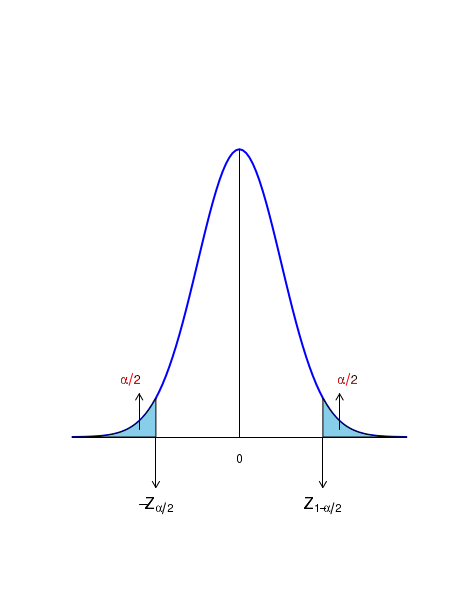CountBio
Mathematical tools for natural sciences
Basic Statistics with R
Confidence interval for a population mean
According to the Central Limit Theorem, the sample mean \(\small{\overline{x}}\) estimated from n random samples from a distribution will be unit Gaussian under the tranformation, \(~~~~~~~~~~~~~~~~~\small{Z = \dfrac{\overline{x} - \mu}{\left(\dfrac{\sigma}{\sqrt{n}}\right)} ~~~is~~~N(0,1) }\) See figure below:
For a given set of values for \( \small{\overline{x}, \mu} \) and \( \sigma \), let \(\small{\alpha}\) be the probability of getting Z values above and below a threshold. Let, \(Z_{1-\alpha/2} ~\) be the Z value above which the area under the curve is \(\small{\dfrac{\alpha}{2} }\). This means, \(~\small{P(Z \gt Z_{1-\alpha/2}) = \dfrac{\alpha}{2}}\) Similarly, \(-Z_{1-\alpha/2} ~\) be the Z value below which the area under the curve is \(\small{\dfrac{\alpha}{2} }\). ie., \(~\small{P(Z \lt -Z_{1-\alpha/2}) = \dfrac{\alpha}{2}}\)
The probability for a Z value in the range \(\small{[-Z_{1-\alpha/2}, Z_{1-\alpha/2}]}\) is \(\small{1-\alpha }\). Therefore, we write this as, \( ~~~~~~~~\small{P(-Z_{1-\alpha/2} ~\leq ~Z \leq ~Z_{1-\alpha/2}) = 1-\alpha }\) Substituting for Z the expression of Z tranform, we get \( ~~~~~~~~\small{P(-Z_{1-\alpha/2} ~\leq ~\dfrac{\overline{x} - \mu}{\left(\dfrac{\sigma}{\sqrt{n}}\right)} \leq ~Z_{1-\alpha/2}) = 1-\alpha }\) We now consider the following inequality : \(~~~~~~~~\small{ -Z_{1-\alpha/2} ~\leq ~\dfrac{\overline{x} - \mu}{\left(\dfrac{\sigma}{\sqrt{n}}\right)} \leq ~Z_{1-\alpha/2} }\) Multiplying throughout by \(\small{\dfrac{\sigma}{\sqrt{n}} }\), we get \(~~~~~~~~\small{ -Z_{1-\alpha/2}\left(\dfrac{\sigma}{\sqrt{n}}\right) ~\leq ~\overline{x} - \mu \leq ~Z_{1-\alpha/2}\left(\dfrac{\sigma}{\sqrt{n}}\right) }\) We add \(\small{-\overline{x}}\) throughout to get \(~~~~~~~~\small{-\overline{x} -Z_{1-\alpha/2}\left(\dfrac{\sigma}{\sqrt{n}}\right) ~\leq ~ -\mu ~ \leq ~-\overline{x} + Z_{1-\alpha/2}\left(\dfrac{\sigma}{\sqrt{n}}\right) }\) Multiplying throught by -1, we can reverse the inequality to get: \(~~~~~~~~\small{\overline{x} + Z_{1-\alpha/2}\left(\dfrac{\sigma}{\sqrt{n}}\right) ~\geq ~ \mu ~ \geq ~\overline{x} - Z_{1-\alpha/2}\left(\dfrac{\sigma}{\sqrt{n}}\right) }\) reading this from left, we get the final result \(~~~~~~~~\small{\overline{x} - Z_{1-\alpha/2}\left(\dfrac{\sigma}{\sqrt{n}}\right) ~\leq ~ \mu ~ \leq ~\overline{x} + Z_{1-\alpha/2}\left(\dfrac{\sigma}{\sqrt{n}}\right) }\) With the above inequality, we can make this final statement:
The above result is a remarkable one. It says the following:
For example, for a given data set, let us fix \(\small{\alpha = 0.05}\). Then \(~~\small{\dfrac{\alpha}{2} = 0.025 }\) and \(~~\small{1 - \dfrac{\alpha}{2} = 0.975 }\). We thus have, \(\small{\overline{x} \pm Z_{0.975} \dfrac{\sigma}{\sqrt{n}}}\) as the \(\small{95\% }\) confidence interval around the estimated mean \(\small{\overline{x} }\). We have to get \(\small{Z_{0.975} }\) from Gaussian table.
The value of \(\small{Z_{0.975} }\) is such that the area under the Unit Gaussian curve from \( -\inf \) to \(\small{Z_{0.975} }\) is 0.975 and consequently the area above \(\small{Z_{0.975} }\) is 0.025. Similarly the area of the curve from \( -\inf \) to -\(\small{Z_{0.975} }\) is 0.025. Understanding the confidence interval on population mean
Suppose we randomly draw \(\small{n}\) data points from a distribution with a given \(\small{\mu}\) and \(\small{\sigma}\). We compute, say, a \(\small{95\%}\) condifence interval on population mean for this sample data. The population mean \(\small{\mu}\) may or may not be within this interval. Now we repeat this whole exercise m times (we call it "m experiments") where m is large. Everytime we pick n random samples, get the sample mean, compute the \(\small{95\%}\) confidence interval and check whether the population mean \(\small{\mu}\) is inside the interval . Note that every time, the population mean will be different, and hence the confidence interval. We expect that out of m such experiments, \(95\%\) of the cases will have the population mean within the confidence interval and \(5\%\) of them will have population mean outside the interval. The confidence interval does not say that \(\small{\mu}\) assumes a value within the interval with a probability 0.95. It does not say anything about the value of \(\small{\mu}\).
Two sided and One sided confidence intervals
The confidence interval \(\small{\overline{x} \pm Z_{1-\alpha/2}\left(\dfrac{\sigma}{\sqrt{n}}\right)}\) gives the \(\small{(1-\alpha)100\%}\) confidence with which we say that the population mean is in the given interval.
This expression gives a two sided confidence interval, since the given \(\small{\alpha}\) is split between the lower and upper bounds of the interval.
Sometimes, we want to estimate only the lower or upper bound within which \(\small{\mu}\) can be located with \(\small{(1-\alpha)100\%}\) confidence. In this case, the entire probability \(\small{\alpha}\) is assigned to one side.
An \(\small{(1-\alpha)100\%}\) upper one sided confidence interval on \(\small{\mu}\) is written as, \(\small{\overline{x} + Z_{1-\alpha}\left(\dfrac{\sigma}{\sqrt{n}}\right)}\)
Similarly, we can write a \(\small{(1-\alpha)100\%}\) lower one sided confidence interval on \(\small{\mu}\) as, \(\small{\overline{x} - Z_{1-\alpha}\left(\dfrac{\sigma}{\sqrt{n}}\right)}\)
Thus, in the case of one sided interval, we compute \(\small{Z_{1-\alpha}}\) instead of \(\small{Z_{1-\alpha/2}}\).
In a food processing unit, a packaging machine prepares 53 gram packages of chocloate chips. In order to check the quality of packing, a ransom sample of 10 packages were pulled out from the assembli line and their weights were independently measured. The data is given below:
\(~~~~~~~~~~\small{56.95, 57.54, 58.58, 56.13, 58.48, 57.06, 60.93, 59.30, 53.57, 59.46 }\)
Assuming that the weight of these packets follow a normal distribution with \(\small{N(\mu, \sigma=4.1) }\), find the \(\small{95\% }\) confidence interval on \(\small{\mu }\).We estimate the mean of the data points as, \(\small{\overline{x} = 57.8 }\) We have, \(\small{n=10, \sigma=4.1 }\) For a \(\small{95\%}\) confidence interval, \(\small{\alpha = 0.05 }\) and \(\small{\dfrac{\alpha}{2} = 0.025 }\) For a two sided confidence interval with \(\small{\alpha = 0.05 }\), we get, from Gaussian table, \(\small{Z_{0.975} = 1.96 }\). With this, we write the two sided confidence interval as, \(\small{57.8 \pm 1.96 \times \dfrac{4.1}{\sqrt{10}} = 57.8 \pm 2.54 }\)
